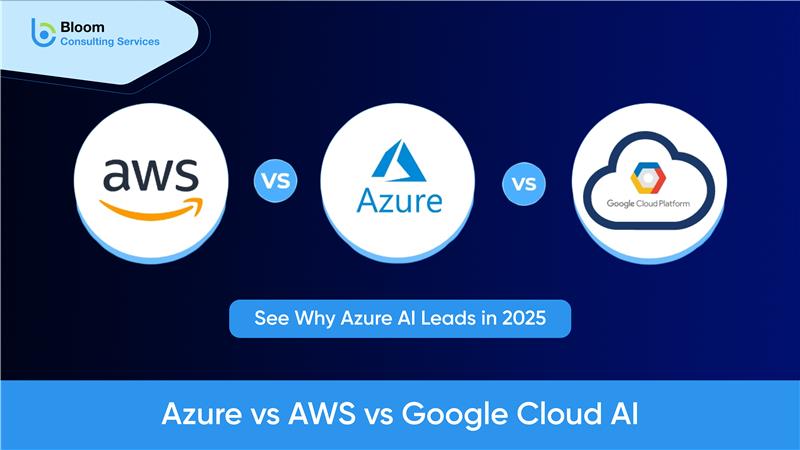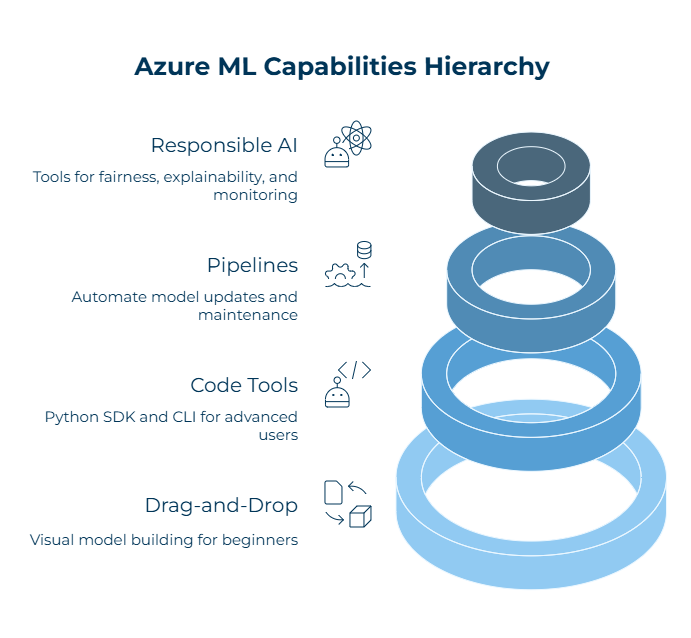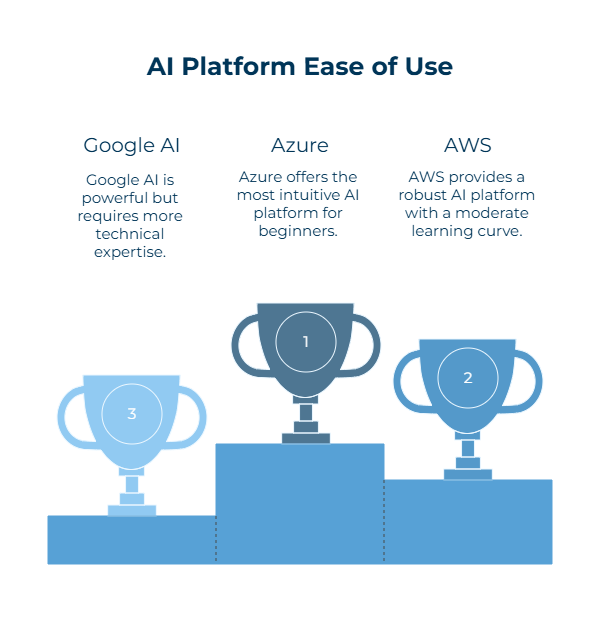Azure AI Services vs AWS & Google AI: Who Leads in 2025?

Artificial intelligence developed quickly, and now the Azure AI Service is making it accessible to the typical, scalable, and enterprise-ready through cloud deployment.
Thanks to AI tools on the cloud, what could have been done earlier with heavy-duty hardware and specialized knowledge can now be done with the selection of buttons.
From chatbots and voice recognition to document processing and predictive analytics, Azure AI is getting businesses faster and smarter innovations without having to start on a new product.
Having established AI as an avenue to growth and digital transformation for organizations, companies are now pitching Azure AI Service against AWS AI Services and Google Cloud AI to see which can offer the most future-proofed platform.
All three confer tremendous capabilities; however, their choice depends on ease of use, cost, integration, and real-world applicability. This blog explores them all and makes a strong case for Azure AI.
Table of Contents
What is Azure AI Service?
Azure AI Service is a collection of cloud services from Azure Cloud that allow developers and businesses to attach AI functionality to applications.
It makes layering intelligence into applications, allowing them to see, hear, comprehend, and decide, simple enough for a non-technical person to approach. They include:
Vision allows the app to recognize objects, read text from images, and understand the contents of a photo or video.
Speech lets the app listen and talk, converting speech to text or vice versa. It translates into some languages as well.
- Language (NLP) – Makes it possible for apps to understand written language, summarize documents, answer questions, or even chat with users.
- Decision-Making – Uses data to let apps make intelligent choices, such as recommending a product or predicting outcomes.
- Agentic AI – Build an intelligent assistant capable of thinking, planning, and acting autonomously to complete assignments.
Azure AI Service also collaborates with other tools, such as Azure OpenAI, Copilot Stack, and Azure AI Studio, fostering the building and management of AI solutions. This will help businesses harness multi-agent coordination, content understanding, and advanced integrations to develop more powerful and useful applications.
How Does Azure Machine Learning Compare?
Azure Machine Learning is a very balanced Platform and quite user-friendly for building and managing AI models. Whether you’re a novice or a pro in the field of machine learning, Azure ML makes the process from start to finish just a little bit smoother.
What Makes Azure ML Special?
Azure Machine Learning services supports the complete machine-learning lifecycle, often called MLOps, everything from training your model to deployment and ongoing upkeep. Here is what it offers:

- Drag-and-Drop Interface: For beginners or quick experiments, you can line up the blocks and build your model visually.
- Code Tools (SDK & CLI): For advanced users who want full control, it supports Python SDK and command-line support in Azure ML.
- Pipelines: Automate the steps so the model retains and updates itself when required.
- Responsible AI: You have built-in tools to assess fairness, explain the results, assess system execution, and monitor performance over time.
This means that Azure ML gives you the best of both worlds, with one being easy to use while the other being highly capable.
AI Platform Comparison: Azure ML vs SageMaker vs Vertex AI
| Feature | Azure Machine Learning | AWS SageMaker | Google Vertex AI |
| Ease of Use | Easy + powerful (drag-and-drop + coding) | Powerful but harder to learn | Developer-friendly, especially with BigQuery |
| Flexibility | Very flexible (GUI + SDK + CLI) | High flexibility, mostly code-first | Limited customization, but simple workflows |
| MLOps Support | Built-in pipelines, tracking, automation | Strong, but needs more manual setup | Decent tools, still growing |
| Enterprise Fit | Great for teams of all skill levels | Best for large, tech-heavy teams | Best for Google Cloud users |
| Responsible AI | Strong tools for fairness and explainability | Basic support | Limited features |
Why Azure ML Wins?
Compared to platforms leaning too heavily on code (like SageMaker) or focusing mainly on analytics (like Vertex AI), Azure Machine Learning offers a perfect balance. It gives data scientists enough flexibility and offers simplicity for business users. It is an enterprise-focused platform for security, governance, and responsible AI.
If you need an AI platform to help build smarter solutions without complexity, Azure Machine Learning is the right choice.
AWS AI Services vs Azure AI Services: Which One’s Right for You?
AWS and Microsoft both offer superb AI options. AWS, however, prides itself on variety, but it also has a reputation for being inconvenient to navigate. On the other hand, Azure AI service aims for simplicity, governance, and quick results-oriented functionality, thus making it more approachable for many businesses.
| Category | AWS AI Services | Azure AI Services |
| Ease of Use | Feature-rich but complex; requires deep AWS knowledge | User-friendly with low-code tools and guided setup are in Azure AI service |
| Core Tools | SageMaker (ML), Bedrock (foundation models), Comprehend (text), Rekognition (vision) | Azure ML, Azure OpenAI, Cognitive Services (vision, speech, language, decision) |
| Integration | Tools can feel siloed; better when already using AWS stack | Seamlessly connected across Azure ecosystem |
| Governance & Security | Strong, but more manual setup needed | Built-in responsible AI, model tracking, and enterprise governance out of the box |
| Getting Started | Steeper learning curve; mostly code-driven | Easier onboarding with drag-and-drop designer, SDKs, and Azure AI Studio |
| Enterprise Fit | Ideal for tech-heavy teams who need full control | Better for cross-functional teams (developers, analysts, business users) |
| Time-to-Value | Slower unless deeply embedded in AWS | Faster ROI thanks to prebuilt models and smoother deployment |
Verdict: AWS vs Azure for AI
AWS AI Services would be chosen if you want to build everything from scratch, have an experienced technical team, and are already extensively invested in AWS.
- Azure AI Services will be chosen if you want to get things done faster, integrate easily, and have tools working flawlessly for a range of data scientists to business users.
If quick building of smart apps without having to piece everything together is the priority, Azure outshines. Given its balance of power and simplicity, it works great for almost any enterprise AI requirement.
Still comparing cloud AI platforms?
Azure vs AWS vs Google AI – Which Is Easiest to Use?

As far as the adoption of AI in the cloud is concerned, the first experience matters. Teams can find it hard to move forward if the platform is difficult to use or confusing. Here is a quick AI cloud comparison among the top cloud service providers: Microsoft Azure, Amazon Web Services (AWS), and Google Cloud Platform (GCP).
All providers bring their strengths, but the onboarding experience and UI differ.
Azure: Best for Business-Friendly Teams
Azure presents a smooth, guided beginning for teams that already use Microsoft tools such as Office, Teams, or Power BI. Features like Azure AI Studio and GitHub integration make it easier for developers and analysts to collaborate. The drag-and-drop designer of Azure Machine Learning is probably designed for new AI users.
Google Cloud: Fast and Clean for AI Experimenting
The UI of Google Cloud is minimal and clean. If you are rushing quick AutoML jobs or feel like having a simple UI to jump into, Google will let you do that easily. It is best for developers and data scientists who want to mess with models.
AWS: Powerful, Yet Complex
While AWS offers immense control and many services, the steep learning curve might shy off a newbie. A UI that sometimes feels disjointed mostly warrants having the fine print of documentation and setup in hand before you begin.
Onboarding & UX Comparison
| Criteria | Azure AI | Google Cloud AI | AWS AI Services |
| Ease of Setup | Very easy; templates, drag-and-drop support | Quick for AutoML; minimal UI | Slower setup; multiple steps and configurations |
| Tutorials & Guides | Rich docs, integrated GitHub samples | Helpful but mostly developer-focused | Detailed, but not beginner-friendly |
| Studio UI | Azure AI Studio: guided, clean, cross-role | Simple and fast; best for AutoML | Limited; tools often separated across services |
| IDE Integration | Built-in VS Code, GitHub Copilot support | Good integration with Colab and Jupyter | Strong with SageMaker Studio, but more complex |
Verdict: Azure Makes Onboarding Easier
All three cloud service providers present strong AI tools, whereas Azure stands out in ease of use, primarily for business-aligned dev teams and cross-functional users. Whatever role you play in the Azure landscape-whether dev, analyst, or product owner-it’s very easy to get started with Azure and collaborate. That ease of use is never at the expense of power or flexibility.
Azure vs AWS vs Google AI – Which Is Easiest to Use?
In AI, picking a cloud vendor is neither just about features nor more about time and value creation. This AI cloud comparison will try to keep in view the onboarding experiences of the top three cloud service providers: Azure AI service, Amazon Web Services (AWS), and Google Cloud.
Azure: Smoothest for Teams and Enterprises
Azure provides good overall experience for developers, analysts, and IT personnel. Using Azure AI Studio, teams can collaborate quite easily with prebuilt templates and effortless GitHub integration. It’s an excellent fit for an organization already on the Microsoft stack (Office, Teams, or Power BI).
Google Cloud: Fastest for Experimentation
Google’s Vertex AI and AutoML tools are recognized for their clean and modern UI. The platform allows for quick setup and rapid experimentation, which is friendly to data scientists and startups working on prototypes or research-heavy projects.
AWS: The Most Powerful, But Complex
On the AWS platform, one gets the largest variety of AI services with SageMaker and Bedrock, but it does come with a greater learning curve. Switching services here feel fragmented, and most setups demand manual effort or expertise on the more technical side.
Onboarding & UX Comparison
| Criteria | Azure AI | Google Cloud AI | AWS AI Services |
| Ease of Setup | Very easy with guided tools and templates | Quick setup for AutoML and basic tasks | Complex; involves multiple services and steps |
| Tutorial Quality | Rich documentation and GitHub-integrated labs | Good for developers; less for business users | Advanced but requires technical background |
| Studio UI | Unified and intuitive; supports all user types | Clean and simple; optimized for data scientists | Split across tools; less intuitive for beginners |
| IDE Integration | Deep GitHub and VS Code integration | Supports Colab and Jupyter | SageMaker Studio; more setup required |
Verdict
All three providers can successfully operate in this environment. Yet Azure is really first when it comes to convenience and onboarding. It represents the best of all worlds in terms of a diverse suite of user-friendly tools, enterprise governance, and cross-team collaboration. For companies contemplating an adoption of AI at scale with minimum friction, Azure AI is more often than not the smartest choice.
Which AI Cloud Is Most Cost-Effective?
Before asking about cost-effectiveness, consider long-term value, flexibility, and predictable billing when comparing cloud storage providers and AI platforms. Here’s how AI-related costs fare among the top three contenders: Azure cloud services, AWS, and Google cloud services.

Azure: Pragmatism Sets the World Apart
Azure cloud services are a solution for enterprises seeking to optimize infrastructure and AI expenditure. Azure supports per-second billing, reserved instances, and good hybrid licensing advantages, especially for Windows and SQL Server workloads. These may reduce the cost of AI training and inference substantially over time.
AWS: Powerful, but it Comes with a Premium
AWS provides high-performance computing and storage for high-performance AI and machine learning workloads. However, training complex models in AWS can be costly, particularly at scale. Their pricing flexibility is robust but typically acts in favour of mature, technically oriented teams.
Google Cloud: Offers Discounts, Less So the Bundles
Google cloud services offer sustained-use discounts and a pure pay-as-you-go model. While this is the best option for startups and researchers, GCP lacks a special bundled incentive that Azure provides. This might count for big organizations trying to pull down costs for the long term.
Cost Comparison – AI Workloads and Storage
| Cost Factor | Azure Cloud Services | Google Cloud Services | AWS |
| AI Training | Competitive pricing, especially with reserved VMs | Lower-cost options available, especially for R&D | High-performing but more expensive at scale |
| Inference Costs | Cost-efficient with autoscaling and caching | Reasonable; some models are optimized | Can be costly without tuning |
| Storage Pricing | Tiered and flexible; hybrid storage support | Simple structure; discounts over time | Durable storage but often pricier overall |
| Hybrid Licensing | Best-in-class (Windows, SQL, Hybrid Benefit) | Limited support | Requires additional licensing or higher pricing |
Verdict
Azure cloud services can be considered inexpensive, more generally than any other AI platform, because they offer flexibility, enterprise readiness, and long-range affordability. Its hybrid perks, reserved capacity pricing, and integration with existing enterprise tools stand above other cloud storage providers, especially when scaling production AI workloads to fill an onward market.
Which Provider Offers the Best Pre-Trained Models?
When selecting a cloud AI provider, one usually considers access to the best and highest-quality pre-trained models. These reduce time and costs and allow businesses to quickly deploy intelligent applications without starting from scratch.
Here’s a quick comparison of Azure AI Service vs AWS AI services vs Google Cloud AI services:
Azure AI Service: Most Versatile and Enterprise-Ready
The leader in this space, Azure, offers enterprise access to a wide variety of top models via Azure Openai Service, including OpenAI’s GPT-4, xAI’s Grok Mini, and Anthropic Claude. A tier above Azure services is enterprise-grade governance, security, and integration within the Microsoft ecosystem, ideal for businesses looking for power and control.
AWS AI Services: Broad Access via Bedrock
AWS hosts pre-trained models via Amazon Bedrock, allowing developers to pick and choose between models from Anthropic, Cohere, Stability AI, and many others. This flexibility limits a smooth experience without an in-depth knowledge of AWS.
Google Cloud AI Services: Strong in Generative and Visual AI
Google Cloud’s Vertex AI platform includes the Gemini model family, excelling at text-to-image, code generation, and multi-modal reasoning. Google’s models are at the forefront of innovation but are better suited for research environments or developer-centric teams.
Verdict
The Azure AI Service again lists the largest and most enterprise-ready array of pre-trained models, secure deployment options, and tight compliance in full integration of the Microsoft stack. Azure is the firmest footing for organizations wishing to scale responsibly and rapidly.
Final Comparison Table
| Category | Azure AI Service | AWS AI Services | Google Cloud AI |
| Ease of Use | ⭐⭐⭐⭐ | ⭐⭐ | ⭐⭐⭐ |
| ML Lifecycle Tools | ⭐⭐⭐⭐ | ⭐⭐⭐ | ⭐⭐⭐ |
| Pre-Trained Models | ⭐⭐⭐⭐⭐ | ⭐⭐⭐⭐ | ⭐⭐⭐⭐ |
| Cost Efficiency | ⭐⭐⭐⭐ | ⭐⭐ | ⭐⭐⭐ |
| Ecosystem Fit | ⭐⭐⭐⭐⭐ | ⭐⭐⭐ | ⭐⭐ |
| Enterprise Readiness | ⭐⭐⭐⭐⭐ | ⭐⭐⭐⭐ | ⭐⭐ |
Summary – Azure AI vs AWS vs Google Cloud AI
Need help choosing the right AI platform?
Conclusion
Among the three big AI cloud platforms, Azure is a highly scaled option for enterprise needs. This is easy to use, has high-quality pre-trained models, integrates well with the Microsoft ecosystem, and provides a cheap pricing option with the benefit of hybrid licensing.
AWS will always be a good choice for very technical teams needing full control, while Google Cloud is best for startups and data scientists focused on experimentation and fast prototyping. However, for scale-at-minimum-friction, fast-time-to-value, and governance-under-the-hood businesses in the adoption of AI, Azure AI Service provides the best overall package.
Guided onboarding, responsible AI features, and an enterprise-ready infrastructure bit of Azure makes it easy for cross-functional teams to innovate confidently. As AI takes charge of shaping the future of digital transformation, Azure has been established to support organizations at every stage of their journey.
Frequently Asked Questions
Q1. What is Azure AI Service?
Azure AI Services is a collection of cloud-powered tools and services offered by Microsoft Azure to enable the development of smart and intelligent applications with ease by developers and organizations.
Q2. Who are the top 3 cloud providers?
The dominant cloud services are Amazon Web Services (AWS), Microsoft Azure, and Google Cloud Platform (GCP) as of 2025. AWS is the market leader with a 29% market share; Azure follows at 22%, and GCP at 12%. These three providers account for about 63% of the global cloud computing market. If you are looking for Azure AI Service, you can visit us here.
Q3. What is the Google Cloud AI platform?
Machine learning is an important technology behind Google Cloud AI’s operations. Specifically, it uses advanced machine-learning methods to treat data, seek patterns, and either predict or perform certain actions. Thus, a developer can choose from a host of ready-made models, each constructed using enormous datasets, to use within his application for AI purposes immediately.



